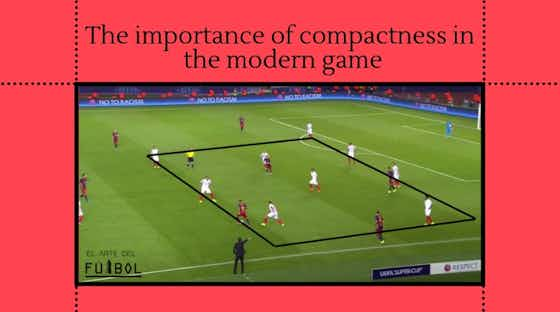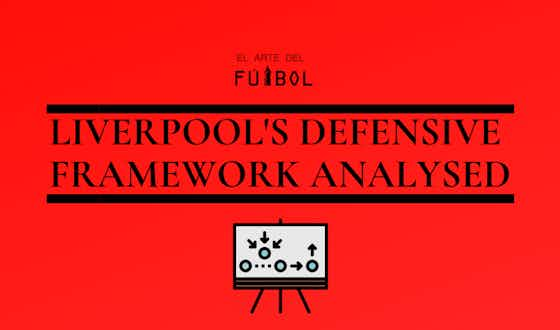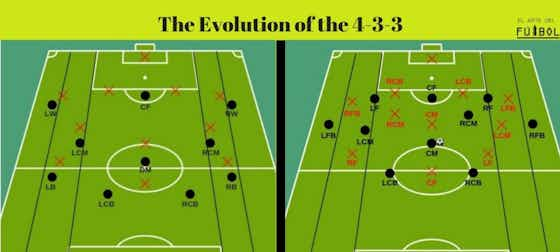El Arte Del Futbol
·1 July 2019
Intracacies of Zonal Defending – Staggering, Compactness, and Spacing

El Arte Del Futbol
·1 July 2019

Football has evolved leaps and bounds over the years, especially in areas pertaining to collective defending. Over the years, teams have adopted different formations, structures, and tactics while defending. However, the basic principles of defending have rarely ever varied. It is based on these principles, that the art of zonal defending has gathered much prevalence over the years. In this respect, let’s dive into the tactical intricacies of it!
As the name suggests, zonal defending essentially refers to the practice of defending multiple zones corresponding to a player’s average position on the football field. It is to be noted that a player’s individual positioning on the field is always strictly in correlation to the four specific reference points – the ball, the space, his teammates and the opponents. Arrigo Sacchi was one of the first proponents of instilling a strict positional discipline in his players as well as employing the four reference points in positioning oneself.
While the ball and the opponents are unpredictable parameters to a certain extent, the space and one’s teammates are more predictable. Numerous hours of extensive training drills impart a subconscious awareness of one’s teammates as well as the available space around a player in a particular formation. Scanning one’s spatial surroundings consistently, in turn, helps a player to be aware of one’s opponents as well as the ball, thereby further facilitating their accurate positioning. This is why players like Xavi, Pirlo, and Co appeared to always exhibit an unreal sense of positioning – owed to their constant scanning of the field throughout the match. And as the positioning of players in a team playing in a specific structure or formation is always relative, it usually gives the visual impression of the team defending and moving as one collective unit.
A player’s positioning in his zone of action determines his defensive access to an opponent in his zone. It also produces the possibility of cover-shadowing opponents and blocking passing lanes to them. This, in turn, immensely helps to minimize the available passing choices for the player with the ball. Atletico Madrid and Liverpool are some of the best clubs at using cover-shadows to block passing lanes.

Defending was and always has been about the collective. However, sometimes players engage in individual defensive actions. These actions – which are neither trained nor in sync with the rest of the team – can often lead to major miscommunication, thus opening up dangerous passing lanes and gaps inside the defensive block, leading to the collapse of the whole system. We often see such instances in various matches. After all, zonal defending is all about the players moving, acting, and defending as one; all relative to one another. Hence, a small misjudgment from a player – like overcommitting oneself or not tracking one’s zonal opponent – can have a counter domino effect on the rest of his teammates.
With online lotteries gaining prominence in the US, take a closer look at the top Lotteries and the different promotions available here.
We often see teams lined up in a 4-4-2 or a 4-3-3, and yet, when they defend, they do not always exhibit such clear lines of 4 or 3. Despite doing so, they may still be actually positioned correctly in relation to their teammates, the opponent, the ball, and the space adjacent to them. This is called staggering and is crucial as it helps teams cover strategically important spaces in the field in a measured way. Without staggering, it becomes much easier for an opponent player to drop-in between the lines of the defending team, receive a pass, turn and run towards the opponent’s defense while combining with his teammates. This clearly displays how, without staggering, a single pass can often completely eliminate the defending team’s midfield and forward lines, leaving them vulnerable.
Teams prioritize protecting certain spaces above others in zonal defending. In an order of predetermined priorities, most teams protect the central spaces followed by the halfspaces and then the wings. The prioritization is based on the fact that more central the space, lesser the distance the opponent has to move the ball to score a goal. Players position themselves compactly, maintaining a sound horizontal and vertical compactness of not more than 10-15m between the lines in this process. They also have to ensure that they do not compress to one flank so much so as to leave the other open for the opponent to exploit.
In the process of defending zonally, teams determine at what height from their goal they defend. Teams that defend in a low block defend closer to their own penalty box. Such teams surrender a large portion of the field to the opponent and prefer clogging the spaces close to their box. Most teams that are weaker on paper adopt a low block against other stronger teams. The attacking team, in such cases, only has to bypass the last line of defense to score a goal. Furthermore, it becomes challenging for the defending team to counter-attack when defending low – as they are relatively distant from the opponent’s goal.

Teams that defend in a midfield block are more balanced in terms of the space they leave behind their backline as well as the space they have to cover upon winning the ball to counter-attack. Atletico Madrid is one of the finest examples of a team that defends most of their matches in a midfield block. Other teams that defend in a high block are those that push their lines relatively higher into the opponent’s half and try to win the ball deep in the opponent’s half. This indicates that they are more deadly when they win the ball back because of the shorter distances they have to cover when counter-attacking. It also means that they leave considerable space behind their back line. Manchester City and Barcelona are exceptional examples of teams defending in a high block.
Shifting is one of the most vital aspects of zonal defending. When the team in possession switches the ball from one flank to another flank, the defending team also has to shift quickly, aggressively, and efficiently in order to compress the space in that ball far side flank. Often, in trying to do so, spaces open up and horizontal compactness gets compromised. Long diagonals have repeatedly been found to be a potent weapon against teams that are not the best at shifting. In matters of shifting, the positioning of the ball far side player of the defending team is crucial with regard to his direct opponent. In simpler words – if the ball far side player of the defending team does not maintain proper defensive access to his direct opponent, then a switch can give invaluable time as well as space to the opponent, which can consequently be used to curate dangerous opportunities. Atletico Madrid and Juventus are some of the most capable teams at shifting and thus, prove themselves to be hard to break down against the use of diagonal balls. Another aspect of zonal defending is the necessity to be spatially aware to not only block passing lanes but also all possible through ball lanes and shooting lanes.
While defending, players act in a certain fashion. They may press or tackle the opponent with the ball actively and aggressively to win the ball back. They may also press passively to force a pass elsewhere. Additionally, players can also position themselves with the right body orientation with the intent of intercepting a pass. The teammates close to the defending player can perform certain actions too. They can choose to cover the position of their teammate, while blocking passing lanes to their direct zonal opponent. They could also choose to strictly stay in their zone and simply cover their direct zonal opponent.
On a football field, these actions and decisions are executed in a matter of seconds. This demonstrates how extreme synchronization, practice, speed of thought, and execution at the highest level are undeniable for the defending team to continue doing this for the entire match.
In the process of zonal defending, all players do not have a similar zone of action. Some are more athletic than others. They are able to defensively access their opponents, despite being relatively farther away from them than their less athletic counterparts. This is why managers around the world are very vigilant in making sure that they don’t pair two or more than two players with poor athleticism in adjacent zones. Players like N’golo Kante’ have a larger zone of action compared to relatively less athletic players like Cesc Fabregas.
With regard to the mechanisms of zonal defending, based on the manager’s philosophy, various teams have different approaches in relation to defensive actions. Certain managers encourage their players to maintain a strictly positional discipline as well as preserve their original defensive structure rather than paying heed to blocking off passing lanes to the opponent in most situations. These teams value their compactness in space both horizontally as well as vertically in all situations. Atletico Madrid is one such team that employs the above approach.

Additionally, there are teams that encourage their players to be tight to their direct zonal opponent, even at the cost of gaps opening up. These teams prioritize man-marking opponents in their zones. Jose Mourinho’s teams are usually set up in this manner. Apart from this, there are teams that set their players up to block passing lanes to the opponent, while defending and trying to cover positions of teammates when they foray forward. Pep Guardiola’s teams are usually set up in this manner.
Another interesting aspect of zonal defending is whether a defending team allows a switch of play to take place through their defensive block. Some teams do so with the intent of trapping the opponent on the ball far side wing. Borussia Dortmund is an excellent example of a team that allows a switch of play through its block to trap it in the ball far side wing. Other teams prioritize collapsing on the opponent as soon as the ball is played inside their defensive block, in fear of further penetration. Red Bull Salzburg, under Roger Schmidt, were ferocious when it came to trapping the opponent inside their defensive block whenever the opponent attempted a switch of play through them.
One of the most significant advantages of being compact in zonal defending is that it invariably suggests that the defending team, upon winning the ball back, will always have a temporary numerical superiority. This, in turn, will be useful for them in order to bypass a counter press of the opponent, and then counterattack.
It is to be noted that when defending zonally, teams that have a symmetrical formation are relatively more defensively secured than those having unsymmetrical ones. Having an unsymmetrical formation means a numerical overload on one side as well as a numerical underload on the other. Opponents often find a way to attack that underloaded side, thereby exposing the frailties of the defending team.
As is evident, a lot of variation exists in the course of zonal defending. These occur because teams vary in their setups, their use of pressing traps, their defensive philosophies, their choice of spaces to press and not press, their choice of players to press and not press, etc.
Zonal defending, is thus, primarily about cohesion as well as collective execution and when done perfectly, it can leave even the most potent of attacking teams completely ineffective.

Feature Image via A Soccer Player’s Complete Guide To The Game






























































